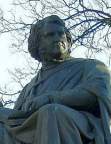Sir James Young Simpson was one of the galaxy of important Scotsmen in the field of medicine in the nineteenth century. Born into a village baker's family in Bathgate, Linlithgowshire, Simpson went up to Edinburgh University when he was 14, started studying medicine at the age of 16, and rose to become an eminent physician and obstetrician. He was given the chair of Midwifery at the University of Edinburgh in 1839, and became the Queen's Physician-Accoucheur in Scotland in 1847, a post he held until his death. In 1850, when he was still only 39, he was elected President of the Royal College of Physicians in Edinburgh.

William Brodie's 1876 sculpture of Simpson in Edinburgh. [Click on thumbnail for larger image.]
Deeply interested in pain relief, Simpson took his clue from Robert Liston's pioneering work with ether at University College, London, and became famous all over the world for introducing the use of chloroform as an anaesthetic: "in the public mind he was undoubtedly endowed with more than human powers, and regarded as a magician, at the wave of whose wand pain and disease would vanish" (Gordon 78). Although his reputation embarrassed him, he was delighted when he heard in 1853 that the Queen had received chloroform for the birth of Prince Leopold. After twice having rejected a baronetcy, he accepted one in 1866, the first doctor or even professor in Scotland to receive such an honour (see Gordon 190).
Simpson was also responsible for many other advances in midwifery, and was much concerned with limiting the spread of infection. His views on hospital design influenced Florence Nightingale.
Malcolm Nicolson describes Simpson as having been "inspiring and vigorous," popular with both students and patients, as well as generous, hospitable and convivial. A devout Christian, he supported the anti-slavery movement. Despite his general benevolence, Simpson was a fierce rival of Sir Joseph Lister's mentor and father-in-law, Sir James Syme, Professor of Clinical Surgery at the same university, and, because of his adherence to the miasma theory of how disease spread, "used his professional stature to ridicule Lister's [antiseptic] method as a hoax" (Pinkus 493).
Bibliography
Gordon, Henry Laing. Sir James Young Simpson and Chloroform (1811-1870). Honolulu: University Press of the Pacific, 2002.
Nicolson, Malcolm. "Simpson, Sir James Young, first baronet (1811-1870)." The Oxford Dictionary of National Biography. Online ed. Viewed 15 April 2009.
Pinkus, Rosa Lynn B. "Medical Science." Victorian Britain: An Encyclopedia. Ed. Sally Mitchell. New York & London: Garland, 1988. 492-494.
Last modified 15 April 2009